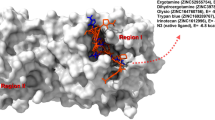Abstract
Few inhibitors of the RNase H function associatesd with the HIV-1 reverse transcriptase have been discovered to date. We observed that three novenamines, U-34445, U-35122, and U-35401, are specific inhibitors of the HIV-1 RT RNase H function. All three compounds are strong amphiphiles and contain one ionizable group. Hence, a priori, in aqueous solutions the inhibitors might exist in at least four different physical states, namely protonated monomers, ionized monomers, protonated micelles and ionized micelles. The three inhibitors all yielded anomalous dose-response curves, indicating that the four molecular species have different inhibitory potentials. In order to identify the inhibitory species, the amphiphilic properties of these compounds were studied. It was established that in alkaline solutions, around pH 8, all compounds are ionized and form micelles at concentrations above their CMC. Both the protonated and the ionized forms of these molecules from stable insoluble monomolecular layers at the air/water interface. The anomalies of the dose-response curves can be resolved by taking into account the fact that, in solution, the relative proportion of these molecules in each physical state depends on the pH and on their analytical concentration. Thus interpreted the results indicate that RNase H is inhibited only by the ionized micellar form of these compounds and not by their monomeric form. Around their pKa (∼pH5) the three componds reproducibly form uniformly sized, self-emulsified colloidal particles that may be used as an efficient drug delivery system.
Similar content being viewed by others
Abbreviations
- HIV-1, HIV-2:
-
human immunodeficiency virus type 1 or 2, respectively
- HIV RT:
-
revese transcriptase
- RNase H:
-
HIV-1 RT associated nuclease
- CMC:
-
critical micellar concentration
- MLV:
-
murine leukemia virus
References
Gellert, M., A. Rev. Biochem.50 (1981) 879.
Reusser, F., and Dolak, L. A., J. Antibiotics39 (1986) 272.
Althaus, I. W., Dolak, L. A., and Reusser, F., J. Antibiotics41 (1988) 373.
Kezdy, F. J., in: Membrane Molecular Biology, pp. 123–145. Eds. C. F. Fox and A. D. Keith, Sinauer Ass. Inc., Publishers, Stamford, Conneticut 1972.
Tanford, C., The Hydrophobic Effect: Formation of Micelles and Biological Membranes, J. Wiley and Sons, New York-London-Sydney-Toronto 1973.
Tate, M. W., Eikenberry, E. F., Turner, D. C., Shyamsunder, E., and Gruner, S. M. Chem. Phys. Lipids57 (1991) 147.
Dolak, L. A., United States Patent # 3,890,2977 (1975).
Althus, I. W., LeMay, R. J., Gonzales, A. J., Deibel, M. R., Sharma, S. K., Kezdy, F. J., Resnick, L., Busso, M. E., Aristoff, P. A., and Reusser, F., Experientia48 (1992) 1127.
S. Arnott, Chandrasekaran, R., Milane, R. P., and Park, H. S., J. molec. Biol.188 (1986) 631.
Zhan, X., Tan, C. K., Scott, W. A., Mian, A. M., Downey, K. M., and So, A. G., Biochemistry33 (1994) 1366.
Davies, J. F., Hostomska, Z., Hostomsky, Z., Jordan, S. R., Matthews, D. A., Ogden, R. C., Varney, M. D., and Stephen, S. E., (1992) PCT Int. Appl. 17182.
Smith, J. S., and Roth, M. J., J. Virol.67 (1993) 4037.
Tan, C. K., Zhang, J., Li, Z. Y., Tarpley, W. G., Downey, K. M., and So, A. G., Biochemistry30 (1991) 2651.
Loya, S., and Hizi, A., J. biol. Chem.268 (1993) 9323.
Hafkemeyer, P., Neftel, K., Hobi, R., Pfaltz, A., Lutz, H., Luethy, K., Focher, F., Spadari, S., and Huebscher, U., Nucleic Acids Res.19 (1991) 4059.
Vonsover, A., Loya, S., Sredin, S., Albeck, M., Gotlieb-Stematsky, T., Araf, O., and Hizi, A., AIDS Res. hum. Retroviruses8 (1992) 613.
Tan, C. K., Civil, R., Mian, M. A., So, A. G., and Downey, K. M., Biochemistry30 (1991) 4831.
Moelling, K., Schulze, T., and Diringer, H., J. Vitro.63 (1989) 5489.
Author information
Authors and Affiliations
Rights and permissions
About this article
Cite this article
Althaus, I.W., Franks, K.M., Langley, K.B. et al. The amphiphilic properties of novenamines determine their activity as inhibitors of HIV-1 RNase H. Experientia 52, 329–335 (1996). https://doi.org/10.1007/BF01919535
Received:
Accepted:
Published:
Issue Date:
DOI: https://doi.org/10.1007/BF01919535




